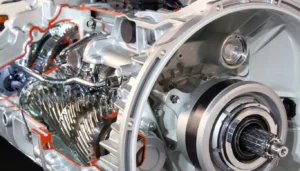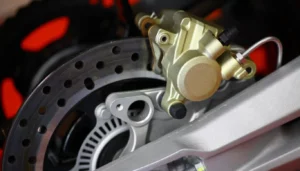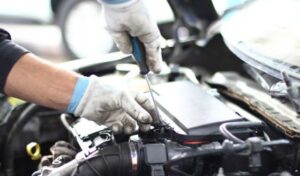Is your vehicle leaving unwanted puddles in your garage? This could be a telltale sign that your car’s radiator has sprung a leak. Leaks not only result in the loss of coolant but also jeopardize your engine’s health, potentially leading to overheating.
In this enlightening guide, we’ll teach you how to identify and repair a radiator leak in your vehicle. With our help, you’ll be able to solve this pesky problem and prevent further damage to your car, ensuring safer and more efficient journeys ahead.
Understanding the Role of Your Car’s Radiator
The radiator is a crucial element in your car’s engine cooling system that helps regulate the engine’s temperature. Its primary role is to prevent overheating which could lead to critical and costly damage. The radiator works in tandem with other components, such as the radiator cap, coolant, and water pump, to ensure optimal engine performance.
Understanding how your car’s radiator functions is vital to maintaining your vehicle’s health. It’ll make it easier for you to interpret the telltale signs of a faulty radiator and initiate timely repairs. Let’s delve deeper into how the car radiator works and its role in your vehicle’s overall operation.
How the Car Radiator Works
The radiator functions by dissipating the heat generated by the engine while it’s running. As the coolant circulates through the engine, it absorbs heat, which is then reduced as it passes through the radiator before returning to the engine to cycle again. This cycle of heat absorption and dissipation keeps the engine within optimal operating temperatures.
Every radiator comprises several components like tubes and fins that work together to ensure effective heat dissipation. The tubes carry the coolant, while the fins enhance heat transfer. Additionally, a built-in fan ensures air circulation, which also aids in cooling hot coolant.
An optimal radiator should facilitate a seamless co-existence of heat dissipation and coolant flow. If any components fail, such as the radiator developing a leak, the balance is upset, leading to potential engine damage.
The Radiator’s Role in Engine Performance
Any disruption to the cooling function of the radiator directly affects engine performance. If the engine gets too hot, it can result in “engine knock,” a common issue when fuel in one or more engines’ cylinders detonates more than once. The vehicle’s fuel efficiency can also be affected as overheating increases fuel consumption.
A well-maintained radiator boosts the longevity of your car’s engine. The engine and other critical components like the cylinder head and engine block have a better chance of lasting longer when running at appropriate temperatures. Overheating can cause cracks and warps in these components, leading to expensive repairs or total engine failure.
Given the critical role of the radiator, it’s essential to regularly check its condition and fix arising issues promptly. One common problem you should be vigilant about is a radiator leak.
Identifying the Signs of a Radiator Leak
expensive repair. This begins with knowing the symptoms that indicate there may be a problem. By being observant, you can identify signs, both subtle and obvious, that your car’s radiator may be leaking.
To ensure the health of your car’s radiator, you need to be mindful of changes in your vehicle’s performance that may signal a leak. Recognizing these signs isn’t always straightforward, as they can be identical to those of other car issues. However, there are certain tell-tale indicators you shouldn’t ignore.
Overheating Engine
One of the first signs of a radiator leak is an overheating engine. It could range from slight increases in temperature noticeable on your dashboard gauge, to your car overheating and breaking down. This happens because the antifreeze is leaking out and your cooling system is unable to regulate the engine’s temperature.
It’s important to note that many factors can cause a car to overheat. Having your mechanic run diagnostic tests can help to confirm if it’s due to a radiator leak.
If you notice a consistent rise in your car’s temperature, it’s about time to check your radiator for potential leaks.
Visible Coolant Leaks
Radiator leaks often result in visible coolant puddles underneath your car. The coolant generally has a bright green, pink, or yellow color, making it fairly easy to spot.
When the car is parked for a while, inspect the ground underneath for any colorful puddles. This is one of the most direct signs of a radiator leak.
Keep in mind, the coolant could also end up on the engine or the radiator itself, evaporating and leaving no visible trace on the ground.
Low Coolant Levels
If your car is losing coolant but there are no visible leaks, it’s possible the coolant is escaping while the car is in motion or leaking in a place that’s not easily visible.
You should regularly check your coolant level to catch potential leaks. If the level is consistently low and you have to frequently top off the coolant, it’s likely that your radiator is leaking.
Unusual Smell
One often overlooked sign of a radiator leak is a strange, sweet smell. The odor comes from the coolant fluid and once you’ve smelled it, you won’t forget it.
If you notice this unusual scent while driving, especially combined with an overheating engine, it’s a clear sign that your coolant is leaking somewhere, possibly from the radiator.
Paying attention to such seemingly small details can save your car’s engine from potential costly damages.
| Sign | Possible Cause | Solution |
|---|---|---|
| Overheating Engine | Leaking Coolant | Inspect Radiator |
| Visible Coolant Leaks | Radiator Leak | Find leak location and repair |
| Low Coolant Levels | Leaking when In Motion | Regular Coolant level check |
| Unusual Smell | Leaking Coolant | Inspect for leaks |
Tools You’ll Need to Fix a Radiator Leak
If you’ve established that your car’s radiator is leaking, and you’re planning on engaging in a DIY fix, here’s a list of the essential tools you’ll require to get the job done efficiently:
- Radiator Flush Solution: This product cleans the cooling system by removing any debris or rust that could cause further leaks.
- Coolant Dye: A helpful tool for detecting where the leak originates. When combined with UV light, it can help you spot even the smallest leaks.
- Pressure Tester: This device is essential for determining the exact source of the leak. By applying pressure to the cooling system, it forces the coolant out from where it’s leaking, making it easier to spot.
- Radiator Stop Leak: A temporary fix that seals small leaks in the radiator and cooling system.
- Screwdriver or Wrench: Depending on your car’s model, you might need one of these tools to access and tighten any loose components.
- New Radiator Coolant: After repairing the leak, you’ll need to replace the old, possibly contaminated coolant with a new one.
- Bucket or drip pan: You’ll need this to catch any dripping coolant whilst you are carrying out the repairs, keeping your workspace clean and preventing any environmental damage.
- Protective Gear: Always prioritize your safety. Gloves and safety glasses will protect your eyes and skin from the harmful coolant.
Remember, it’s important always to use the right tools for the job. Misusing tools or using inappropriate ones could lead to further damage.
Step-by-Step Guide to Diagnosing Radiator Leaks
Initiating the process of diagnosing a radiator leak involves a systematic approach. You should first ensure your car is parked on a flat and level surface, with the engine turned off and cool to touch to avoid personal injury. Never open the radiator cap of a hot engine.
Here’s a step-by-step guide to help you out:
- Inspect the engine compartment: Look for visible signs of coolant leakage. It may have a greenish, pink, or yellow color and a sweet smell. Check the hoses, radiator, and radiator reservoir for signs of dampness or staining.
- Check underneath your car: After your car has been parked for a while, actively search for puddles or streaks of coolant on the ground. This could be a strong indicator of a radiator leak.
- Examine the radiator cap: Carefully release the pressure in your cooling system by slowly turning the cap. If you notice a damaged or worn out seal on the cap, it may be the source of the leak.
- Use a pressure tester: This tool can help determine where the leak is coming from. By applying pressure to the cooling system, you’ll be able to see whether or not it holds. If it doesn’t, closely inspect the system to find the leak.
Remember, if you can’t find the leak or if it’s inaccessible to repair yourself, it’s best to take your vehicle to a professional mechanic. They will use their expertise to diagnose and fix the problem correctly, preventing further damage to your vehicle.
Proven Methods to Fix a Car Radiator Leak
Addressing a car radiator leak promptly is vital to maintaining the performance and longevity of your car. Leaving a leak unattended worsens the damage, potentially causing costly repairs and even a total engine meltdown. Fortunately, numerous proven methods exist to address this problem directly, with many being achievable right at home.
Below, we delve into these effective methods. We cover you every step of the way, from implementing quick, temporary fixes to opting for more permanent solutions. Remember, your safety is paramount, so ensure to follow these instructions carefully and use protective gear when needed.
Quick Fixes
Catch these early leaks for a temporary solution, providing valuable time until a professional intervenes or schedules a more in-depth repair.
Commercial Radiator Sealants: These are widely available in stores and work by plugging the leak internally via the coolant system. However, keep in mind that they can only repair small leaks.
Epoxy: This is a strong adhesive that you can apply to the leak area after cleaning it thoroughly. This fix is stronger than sealants but may still require a permanent solution eventually.
Long-term Solutions
Permanent solutions are typically more involving and may require a professional unless you’re comfortable with DIY projects. The goal here is to repair the radiator to its optimal functional condition.
Radiator Replacement: If the radiator is severely damaged or corroded, you may need to replace it completely. This solution is incredibly effective as it completely resolves the problem, but it can be costly.
Professional Welding: If the leakage is due to cracks or holes, a pro can weld back the affected areas. This method is however not advisable for plastic radiators.
Understand the Situation
Deciding the right way to fix your radiator leak means understanding the severity and the source of the leak. Smaller, manageable leaks can often be addressed with quick fixes, while larger, more severe leaks may require professional attention or a full radiator replacement.
| Symptom | Suggested Fix |
|---|---|
| Small leaks – Single drops or a slow drip | Commercial Sealants or Epoxy |
| Medium leaks – Steady dribble to a small stream | Professional Welding or Epoxy |
| Large leaks – Rapid stream or a pool of coolant | Radiator Replacement |
In all cases, ensure to monitor your vehicle’s performance following any repair, to ensure the leakage has been fully arrested. No matter the extent of the leak, always consider consulting a professional to help assess the situation.
Final Thoughts on Radiator Leak Prevention and Repair
In essence, understanding, identifying, and addressing a radiator leak promptly could mean the difference between routine maintenance and an expensive overhaul. Education about your car’s coolant system and vigilance in spotting early signs of a leak ensures ongoing vehicle health and helps maintain optimal engine performance.
Every car owner must have the essential skills to fix minor problems like a radiator leak. While temporary fixes facilitate immediate relief, long-term solutions are instrumental for a truly functional and healthy radiator. And always bear in mind: if in doubt, seek assistance from professional car mechanics to prevent further damage to your vehicle.






